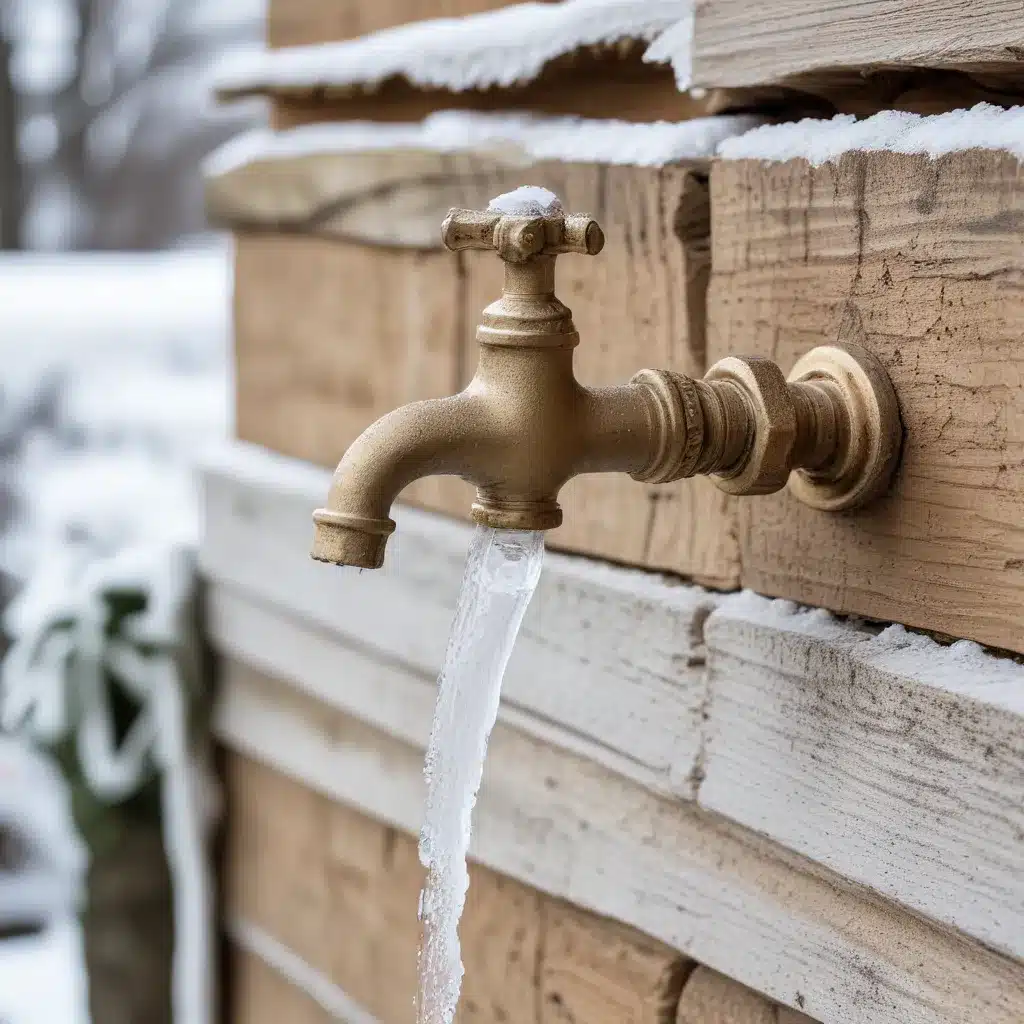
Protecting Your Outdoor Faucets from Winter’s Wrath
As the temperatures begin to drop and winter approaches, it’s crucial to take proactive steps to safeguard your outdoor faucets and prevent the dreaded frozen pipe dilemma. Frozen outdoor faucets can not only disrupt your water supply but also lead to costly plumbing emergencies if left unattended.
In this comprehensive guide, we’ll explore practical strategies to shield your outdoor faucets from the harsh winter elements, as well as provide step-by-step instructions on how to thaw a frozen faucet and mitigate any potential water damage.
Understanding the Dangers of Frozen Outdoor Faucets
When water inside the outdoor faucet and its connecting pipes freezes, it can create tremendous pressure that can damage the faucet components and rupture the pipes. This damage can then extend to the internal plumbing system, leading to burst pipes and flooding within your home.
The problem is compounded by the fact that the pipes behind the outdoor faucet are often part of the network that supplies water to the rest of the house. A frozen outdoor faucet can therefore have a domino effect, potentially causing flooding in the basement, throughout the home, and even into the walls.
Preventing Frozen Outdoor Faucets
The best approach to dealing with frozen outdoor faucets is to take proactive measures to prevent them from freezing in the first place. Here are some effective tips:
Disconnect and Drain Hoses
As the temperatures start to drop, it’s crucial to disconnect and drain any hoses attached to your outdoor faucets. Leaving hoses connected can prevent the water inside the faucet from draining, making it more susceptible to freezing.
Close the Interior Shut-Off Valve
Most homes have an interior shut-off valve for the outdoor faucet, typically located near the faucet or in the basement. Before the winter months, make sure to locate this valve and turn it off, then open the outdoor faucet to drain any remaining water.
Insulate the Outdoor Faucet
Investing in an insulated faucet cover or wrapping the faucet with insulation can significantly improve its resistance to freezing. The key is to create a barrier that traps heat and prevents the cold air from reaching the faucet and its connecting pipes.
Consider a Frost-Proof Faucet
For homeowners in colder climates, upgrading to a frost-proof outdoor faucet can be a game-changer. These faucets are designed with the shut-off valve located inside the home, significantly reducing the risk of freezing.
Monitor Weather Forecasts
Keep a close eye on the weather forecast, especially during the transitional seasons of fall and spring. When a cold snap is predicted, take the necessary precautions to protect your outdoor faucets, such as insulating them or turning off the water supply.
Thawing a Frozen Outdoor Faucet
If you find yourself dealing with a frozen outdoor faucet, don’t panic. With some patience and the right approach, you can safely thaw the faucet and prevent further damage. Here’s a step-by-step guide:
-
Open the Faucet Handle: Start by opening the faucet handle all the way. This will allow the water to flow once the frozen section has been thawed.
-
Insulate the Faucet: Wrap the faucet, including the handle, spindle, and supply pipe, with old rags or towels. This will help retain the heat and speed up the thawing process.
-
Apply Heat: Carefully pour hot water over the wrapped faucet, slowly saturating the insulating material. Repeat this process until you start to see a steady trickle of water from the faucet. Avoid using open flames or high-heat devices, as they can cause damage to the faucet and surrounding areas.
-
Let the Water Flow: Once the faucet has begun to thaw, let the water run for several minutes to ensure any remaining frozen sections in the pipes behind the faucet have also thawed.
-
Check for Leaks: After the thawing process, turn the faucet off briefly and then turn it on again. Inspect the area for any signs of leaks or ongoing issues.
If you’re unable to thaw the faucet using the hot water method, you can also try using a hair dryer or specialized heat tape. However, these approaches require access to an electrical outlet, so be cautious and follow the manufacturer’s instructions.
Remember, the key to successfully thawing a frozen outdoor faucet is to work slowly and avoid applying excessive heat, which could lead to further damage.
Preventing Future Freezing Issues
To avoid dealing with frozen outdoor faucets year after year, consider implementing long-term solutions that can provide lasting protection:
Install Frost-Proof Faucets
Upgrading to frost-proof outdoor faucets is one of the most effective ways to prevent future freezing problems. These faucets are designed with the shut-off valve located inside the home, significantly reducing the risk of freezing.
Insulate Pipes and Faucets
Investing in insulation for your outdoor faucets and the connecting pipes can make a significant difference in their ability to withstand the cold. Look for specialized insulation kits or use weather-resistant materials to create a barrier against the elements.
Consider a Heated Faucet Cover
For added protection, you can install a heated faucet cover that plugs into an electrical outlet. These covers use a heating element to maintain a consistent temperature around the faucet, preventing it from freezing even in the harshest winter conditions.
By taking proactive steps to protect your outdoor faucets, you can avoid the frustration and potential water damage caused by frozen pipes. Remember, a little preparation and maintenance can go a long way in ensuring your home’s plumbing system remains in top condition throughout the winter months.
If you encounter any issues with your outdoor faucets or require professional assistance, don’t hesitate to reach out to the experts at DD Plumbing and Heating. Our experienced technicians are always ready to provide reliable and efficient solutions to keep your home’s plumbing and heating systems running smoothly, no matter the season.


